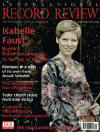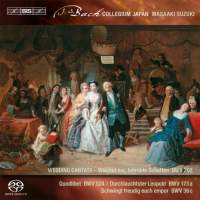Texte paru dans: / Appeared in:
*

International Record Review - (09//2013)
Pour
s'abonner / Subscription information
BIS
BIS2041

Code-barres / Barcode : 7318599920412
Consultez toutes les évaluations recensées pour ce cd
~~~~ Reach all the evaluations located for this CD
Masaaki Suzuki’s survey of Bach’s sacred cantatas is now entering its final phase and we have also reached the third volume of his companion series of the secular cantatas. In fact, the demarcation lines between Bach’s sacred and secular works are less strict than one might imagine. Large-scale cantatas and serenatas, like Durchlaucht’ster Leopold (written around 1720 for the birthday of Bach’s employer Prince Leopold of Anhalt-Köthen), would have had only a single performance before a small and select audience. To get value for money out of all his hard work, Bach later engaged a poet to clone the texts of the arias — now with sacred words — so that he could reuse the music in church with minimal change. Thus, in 1724, Durchlaucht’ster Leopold became the Whit Monday cantata Erhötes Fleisch und Blut - and no one in his Leipzig congregation would have been any the wiser. Schwingt freudig, BWV36c was a particular favourite of Bach’s: originally written in the spring of 1725 for the birthday of a revered Leipzig teacher, it was furnished with a new text and recitatives in 1726 as a birthday cantata for Countess Charlotte of Arnalt-Köthen; a year or two later it was transformed into an Advent cantata, and finally in 1735 it got yet another new text and was performed in honour of a member of the Rivinus family of Leipzig scholars.
So, this new recording offers us both Durchlaucht’ster Leopold, BWV173a and Schwingtfreudig, BWV36c in their original form, though not in attention-grabbingly secular performances. Soprano Joanne Lunn opens Durchlaucht’ster Leopold with a brilliant, coloratura salute to Prince Leopold and is sparklingly clean and clear in her two attractive arias. Roderick Williams partners her neatly in the two courtly minuets which they share, though Suzuki could have made more of the first of these — the three-verse duet ‘ Unter seinem Purpursaum ‘ — which is written as a set of variations, with beautifully worked instrumental support (including flutes in the second verse). Here the duet lacks just a little joie de vivre and cumulative power, though Suzuki’s natural reserve pays dividends in the bass aria ‘Dein Name’, where he keeps the mischievous bassoon in line — just. In Schwingt freudig the solo team is expanded to three singers and the two flutes are replaced by an oboe d’amore which in the hands of Masamitsu San’nomiya is the chief bringer of cheerfulness in the opening chorus and the tenor aria ‘ Die Liebe’‘ , which is sweetly, if not precisely or compellingly, sung by Makoto Sakurada. Williams is a trifle uncomfortable in ‘Der Tag’, fractionally insecure in tone and pitch, despite the jolly orchestral support. The tuning of the viola d’amore is also a little edgy in Lunn’s glowing ‘Auch mit gedämpften’, and the slow tempo is perhaps more successful in the aria’s outer sections than the central portion, where at low velocity the charming echo effects can sound somewhat laboured.
We don’t know the name of the couple for whom Bach wrote the charming Weichet nur, BWV2O2, but the wedding ceremony clearly took place in the spring, for the opening number tells of the disappearance of frost and wind, and in the following four movements the unknown librettist delights in evoking the charm of the reawakening countryside. The first aria is perhaps the most impressive and Lunn’s resolutely unsentimental approach to the text (‘Away now, dismal shadows, frost and wind, go to rest’) seems to suggest that the course of true love had not run true in the preceding winter. Optimism bubbles up unceasingly in the following aria — full of the sound of Phoebus’s galloping horses — while Lunn and the solo fiddle tease each other, like new lovers, in ‘Wenn die Frühlingslüfte’. Connubial happiness is sealed in a final Gavotte, so unusual for Bach, that it may well have been a special request by the bride or groom. Lunn brings a very light touch to this well-known movement, as do the single strings which have ensured intimacy throughout.
Finally, the more down-to-earth wedding celebrations of the Bach family itself are celebrated in a fragment of a work which, amusingly, begins mid-phrase on the word ‘Steiss’ (‘backside’). Suzuki rather coyly says in his note that ‘backside’ often refers ‘to the tail of a bird or animal, but it is unclear what it could mean in this context’. Oh, come on. The great gatherings of the extended Bach family in Arnstadt and Eisenach were well known for their earthy fun and games. One account tells us that after a devotional chorale ‘they sang popular songs which were partly comic and partly bawdy’. These were a Bach speciality and were improvised from snatches of well-known tunes: one eyewitness tells us that this kind of extemporary harmony they called a Quodlibet, and they not only laughed heartily at it themselves, but it excited an equally hearty and irresistible laughter in all who heard them’.
I’ve never heard Suzuki and the Bach Collegium having so
much fun as they do here . . . conjuring up all the merriment of slightly
inebriated music-making (complete with plenty of sound effects). This is
undoubtedly the most convincing and enjoyable performance of the Quodlibet,
BWV524- I’ve heard, even down to the final bar, where, with the loss of the
final page, the music suddenly breaks off and the performers simply take a
noisy breath for their next phrase, which never comes! It’s a shame that
just a little of the enthusiasm expended here couldn’t have spilled over
into the accompanying cantatas, which, marked by measured speeds and a
deliberate avoidance of emotional over-statement, ultimately sound just a
little prim. Lunn is the main attraction, an ideal Bach soprano balancing
agility sharp tonal precision and real text-awareness: intelligence and
tonal beauty all in one. I, for one, very much look forward to her next
release with Suzuki.
Fermer la fenêtre/Close window
Cliquez l'un ou l'autre
bouton pour découvrir bien d'autres critiques de CD
Click either button for many other reviews


